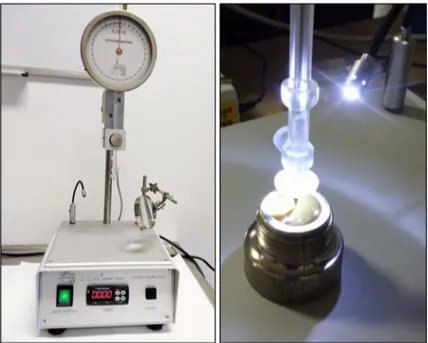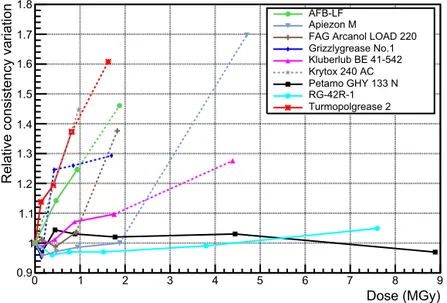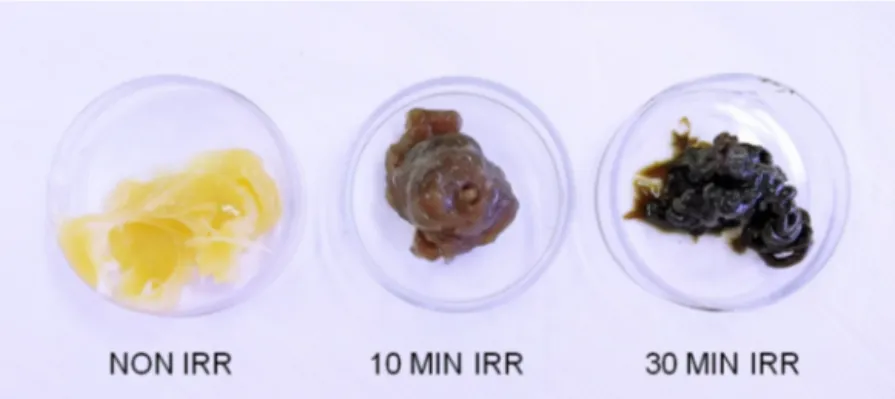Contents lists available atScienceDirect
Heliyon
www.elsevier.com/locate/heliyon
Experimental
study
of consistency
degradation
of
different
greases in
mixed
neutron
and
gamma
radiation
Matteo Ferrari
a,b,∗,
Aldo Zenoni
a,b,∗,
Monika Hartl
c,
Yongjoong Lee
c,
Alberto Andrighetto
d,
Alberto Monetti
d,
Andrea Salvini
e,
Fabio Zelaschi
eaDipartimentodiIngegneriaMeccanicaeIndustriale,UniversitàdegliStudidiBrescia,ViaBranze38,I-25123Brescia,Italy bIstitutoNazionalediFisicaNucleare,ViaBassi6,I-27100Pavia,Italy
cEuropeanSpallationSource,Odarslövsvägen113SE-22484Lund,Sweden
dLaboratoriNazionalidiLegnarodell’INFN,Vialedell’Università2,I-35020Legnaro(PD),Italy
eLaboratorioEnergiaNucleareApplicataLENA,UniversitàdegliStudidiPavia,ViaAselli 41,I-27100Pavia,Italy
A
R
T
I
C
L
E
I
N
F
O
A
B
S
T
R
A
C
T
Keywords: Materialsscience Aerospaceengineering Industrialengineering Nuclearengineering Materialschemistry Mechanicalengineering Nuclearreactorirradiation Polymerdegradation Neutrondamage Lubricatinggrease Radiationeffect MixedradiationfieldManyofthemovingcomponentsinacceleratorandtargetenvironmentsrequirelubrication.Lubricantsinsuch environmentsareexposedtohighfluxesofsecondaryradiation,whichoriginatesfrombeaminteractionswith thetargetandfrombeamlosses.Thesecondaryradiationisamixofcomponents,whichcanincludesignificant fractionsofneutrons.Lubricantsareradiation-sensitivepolymericmaterials.Theradiation-inducedmodifications oftheirstructurereducetheirservicelifetimeandimposeadditionalfacilitymaintenance,whichiscomplicated bytheenvironmentalradioactivity.Thestudyofthelubricantsradiationresistanceisthereforenecessaryforthe constructionofnewgenerationacceleratorsandtargetsystems.Nevertheless,datacollectedinmixedradiation fieldsarescarce.NinecommercialgreaseswereirradiatedataTRIGAMarkIIResearchReactortoservefor theconstructionofnewacceleratorprojectsliketheEuropeanSpallationSource(ESS)atLund(Sweden)and SelectiveProductionofExoticSpecies(SPES)atLegnaro,(Italy).Mixedneutronandgammadosesrangingfrom 0.1 MGyto9.0 MGyweredeliveredtothegreases.Foranexperimentalquantificationoftheirdegradation, consistencywasmeasured.Twoofthegreasesremainedstable,whiletheothersbecamefluid.Post-irradiation examinationsevidencethecleavageofthepolymericstructureasthedominantradiationeffect.Doseandfluence limitsfortheuseofeachproductarepresented.Apartfromthescientificsignificance,theresultsrepresentan originalandusefulreferenceinselectingradiationresistantgreasesforacceleratorandtargetapplications.
1. Introduction
Polymericmaterialsusedinhighpoweracceleratorandtarget envi-ronmentsareexposedtomixedradiationfields.Neutronsandgamma canrepresentsignificantcomponentsofthesefields.Theabsorbeddose duetodifferentradiationscausesstructuralmodificationsofthese mate-rials.Radiationsaffectpolymersmainlythroughthebasicmechanisms ofcleavageandcross-linkingofmacromolecularchains[1,2,3]. There-fore,significantradiation-inducedmodificationsoftheirphysicaland mechanicalpropertiescanbeinduced,whichcouldleadtoapremature failureofthecomponents.
TheEuropeanSpallationSource(ESS)projectisunderconstruction inLund,Sweden,aimingatbecomingthebrightestneutronsourcein theworld[4].TheSelectiveProductionofExoticSpecies(SPES)facility
*
Correspondingauthorsat:DipartimentodiIngegneriaMeccanicaeIndustriale,UniversitàdegliStudidiBrescia,ViaBranze38,I-25123Brescia,Italy.E-mailaddresses:[email protected](M. Ferrari),[email protected](A. Zenoni).
isbeingbuiltinLegnaro,ItalyaimingatproducingintenseRadioactive IonBeamsviafissionreactionsoccurringin itstarget[5,6].Bothof theirtargetswillproduceintensemixedfieldsofneutronsandgamma radiation.ElastomericO-rings,lubricatingoilsandgreasesare neces-sarilyemployedintheirtargetareas.Astheyareexposedtosecondary neutronsandgammas,theirmodificationsmustbeevaluatedforsafe andreliablefacilityoperations.Unfortunately,radiationdamagedata onpolymersinneutronfieldsandinmixedradiationfieldsarescarce intheliterature.
Mostoftheavailabledataoriginatefromtechnicalreportsproduced byscientificorganisationsandbycompaniesmanufacturingproducts certifiedtoberadiation-resistant.TheYellowReportsfromCERNare oneofthewidelyusedreferencesconcerningtheradiationresistance ofpolymericmaterials.ResultsonseventypesofelastomericO-rings
https://doi.org/10.1016/j.heliyon.2019.e02489
Received18February2019;Receivedinrevisedform10April2019;Accepted27August2019
2405-8440/©2019TheAuthor(s). PublishedbyElsevierLtd. ThisisanopenaccessarticleundertheCCBY-NC-NDlicense( http://creativecommons.org/li-censes/by-nc-nd/4.0/).
availableontheCERNstoreshelvesandtwotypesoflubricatingoils irradiateduptoseveral MGyofgammadosearereportedinRef. [7]. Greaseswerenotanalysed.
InanITERreport [8],twocommercialelastomericgasketsandfour greasesdeclaredbytheproducer asradiation-hardweretestedupto highgammadosesfrom10 MGyto100 MGy.Arecentwork[9] iden-tifiesO-rings,lubricantsandcableinsulatorsamongthemostcritical componentsintheITERdesign.Radiationeffectsonoilsandgreases evaluatedintheviewpointoftheirchemicalcompositionarereported inRefs. [1] and[10].Neutronandgammairradiationdataontwelve solidlubricantsarereportedin [11].
Theavailableliteratureontheradiationeffectsinpolymersisnot satisfactoryfortheconstructionofnewacceleratorsandtarget facili-ties.Infact,mostofthestudieswereperformedmorethanadecade ago.Consideringtherapidevolutionoftheindustrialproduct develop-ment,mostofthetestedproductsarenowoutdated.Furthermore,most oftheliteratureanddataavailablebymanufacturerslackdetailsabout theirradiation conditionssuch asradiation type,doserate,presence ofoxygenandlinearenergytransfer(LET),whichinfluenceradiation effectsinpolymers [12,13].Lastly,most ofthestudiesusedgamma sources,althoughacceleratorandtargetenvironmentsgeneratemixed radiationfields.Insomeofthemneutronsrepresentthedominant com-ponent.
Gammasourceshavebeenpreferredtoneutronsourcesfor materi-alstestingbecauseoftheirwideravailabilityandbecausetheirradiated samplesmaintainamuchlowerresidualactivation.Ithasbeenbelieved thattheradiation-induceddamagedependsonthetotalamountof ab-sorbed doseonly,irrespectively of thetypeofradiation [7, 14, 15]. Accordingly,thepolymersradiationresistancehasbeenexpressedin termsofgammadoseanddirectlytranslatedtoneutronandmixedfield dose.Nevertheless,theequivalenceofgammaandneutrondoseshas notbeentheoreticallyverifiednorexperimentallyvalidated.
Contrarytotheassumedequivalencebetweengammaandneutron doses,itisreportedinRef. [1] thattheeffectsofmixedreactor radia-tioninpolymersmightdifferfromthatofgammaalone.Thedatahere presentedchallengethislongbelievedequivalenceaswell.InaUKAEA report [16],theneedforestablishingmorepreciselytherelativeeffects of similar dosesof neutrons andgammas isaddressed. In aseminal studyperformedatORNL,theradiationdamageinducedinelastomers byreactorradiationiscomparedwiththedamageproducedby differ-entgammasources.Itwasreportedthatsimilardamagesareinduced bydosesofthetworadiationsthatcandifferofafactortwo[17].In amorerecentwork,theunderstandingofradiationeffectsinpolymers andtheirdependenceontheradiationtypologyareclearlystatedasone ofthemostimportantproblemstobesolved[18].Accordingto Riva-tonandArnold,fastneutronseffectsonorganicmaterialsarenotfully understooddespitetheirrelevanceinthenuclearengineeringandnew investigationsareneeded[19].Thefullcomprehensionof theeffects ofintenseneutronfieldsinpolymersisreportedasarequirementfor theirapplicationinnucleartechnologybyBoninetal. [20].Theneed forresearchonfastneutroneffectsonpolymersisreportedbySeguchi etal. [3].Theyreportaswellthelackofsuchstudiesintheliterature, whichisdominatedbygammaradiationstudies.
Forthementionedreasons,radiationdamageonpolymeric materi-alshastobefurtherinvestigated.Inparticular,mixedradiationdataare necessaryforthedesignandconstructionofnewfacilitiesproducing in-tenseneutronfields.Wededicatedapreviousstudytothedevelopment ofamethodologyfortestingelastomericO-ringsirradiatedinneutron andgammamixedfields [21].Afollowingstudywasdedicatedtothe experimental determinationof theend-of-lifeconditionsofaspecific EPDMO-ringtobeinstalledinagatevalveoftheSPESfacility.It rep-resentsanexampleofthedesignofacomponentwhichoperatesina mixedneutronandgammaradiationenvironment [22].The manage-mentof theSPESfacilityasanintenseneutronsourceis detailedin [23].The problemof theradiationresistanceof lubricants isbriefly mentionedtherein.
In this framework, the present study is dedicated to lubricating greases. A methodology for greases irradiation in a mixed neutron andgammareactorfieldwasdeveloped.Post-irradiationexaminations basedonconsistencyevaluationswerecompleted.Thechosen defini-tionof dosethresholdsallowedtheselectedproductstobe compara-tivelyevaluated.
InSection2.1adescriptionofthecommercialproductsselectedfor thisstudycanbefoundaswellastheirmostrelevantproperties.Seven ofthemostimportantgreaseproducers intheworldhave been con-sidered.InSection2.2adescriptionofthemixedneutronandgamma irradiationfacilityof aTRIGAMarkIInuclearresearch reactorused forsampleirradiationisreported.InSection2.3adescriptionof the dosecomponentsabsorbedbythedifferentgreasesintheneutronand gamma irradiation mixed field is detailed. The methodology devel-opedtoirradiateandtestthegreaseevolutionwithdoseisreported inSection2.4.Consistencyischosenasthemostsignificantindicatorof radiation-inducedgreasedeterioration,asreportedinSection2.5. Re-sultsonninegreasesirradiatedinarangebetween0.1 MGyand9 MGy ofabsorbeddose areshown in Section3. Experimentalevidences of radiation-inducedcleavageofthegreasestructurearereportedin Sec-tion4.1whereasconsiderationsonthegreaseradiationresistanceasa functionoftheirchemicalcompositionsarereportedinSection4.2.In thediscussionsection,thegreasesarecomparedbasedontheir consis-tency.Doseandparticlefluencethresholdsaredefinedtoestimatethe usabilityofeachgrease,asreportedinSection4.3.Consistencyresults arecomparedwiththeradiationresistancedeclarationsofthe produc-ersinSection4.4.Thepossibilityofusingthepresentresultstoforesee theend-of-lifegreaseconditionsinspecificapplicationsisdiscussedin Section4.5.ConclusionsaredrawninSection5.
2. Productselectionandtestingmethodology
Greases aresemi-fluid to solid systemsoriginating from the dis-persionofathickenerin aliquidoil[1].Astandardgreasecontains about85%base oil,10%thickenerand5%other additives.Greases arecomplexmulti-phasesystemswhosechemicalandphysical proper-tiesoriginatefromthecoexistenceandinteractionoftheircomponents [24].
Theradiationresistanceofbaseoils isreportedtopredominantly dependontheiraromaticcontent.Ahighercontentofaromatic struc-turesisassociatedtoahigherstabilityoftheoilviscosityasafunction oftheabsorbeddose.Forthisreason,greasesbasedonaromaticand polyetheroilsareconsideredmoreradiationresistantthanmineraloil basedones[1] [10].However,theexperimentaldataherepresented challengethisgeneralstatement.
Theacademicliteratureon theradiationresistanceof lubricating greasesisverylimited,asreportedbyR.M.Mortieretal. [24].Forthis reason,inthepresentpaperalltheavailableinformationprovidedby theproducersisusedasreferencetoo.Radiationeffectsingreasesare complicatedbytheinteractionofthebaseoilwiththethickenerand theadditivesandtheoveralleffectisexpectedtodependnotonlyon theeffectsonitsbulkcomponents,butontheircomplexinteractionas well.
Sincetheavailableinformationonthegreaseradiationresistanceis solimited,awideandqualifiedspectrumofproductstobetestedwas necessary.Amarketresearchhasbeencompletedtoselect:i) experi-encedcompaniescertifyingaqualitycontrolonthegreaseproduction; ii) greasesdifferinginthechemicalcompositionsoftheircomponents; iii) bothgreasesdeclared asradiation resistantbytheproducer and genericones;iv) greaseshavingdifferentfeatures:vacuum compatibil-ity,extremepressureresistanceandextremeduration.
Thesecriterialeadtoaselectionofhigh-qualitygreasessuitablefor differentapplicationsinacceleratorandtargetenvironments.
2.1. Selectedlubricatinggreases
Ninecommercial greaseswereselected from themarket(see Ta-ble1).Indicationsabouttheirchemicalcompositionareprovidedby theproducerandreportedindatasheets.Consistency,whosevalueis reportedasaNLGIclass,isoneofthemostrelevantproperties charac-terizingthegrease [24].
Thenineselectedgreasesandtheirmajorpropertiesarelisted be-low:
• AFB-LFisproducedbyTHK(Japan).Itisageneral-purposegrease forbearingapplications,manufacturedusingarefinedmineraloil andaLibasedthickener.Itfeaturesextremepressureresistance andhighmechanicalstability.
• ApiezonM is producedby M&IMaterials(UnitedKingdom).1 It
isdevelopedforvacuumuseanditisdeclaredasradiation resis-tantuptoabout1 MGyofdosedeliveredusinga4 MeVelectron beam.Apiezon Mismanufacturedwithahydrocarbonoilandit is halogenfree. This is an advantage for applications in radia-tionenvironment,becausehalogenscanevolveacids.Apiezon M is manufacturedwithout athickener. Forthis reason,itis more properlyreferredasaveryviscousfluidratherthanagrease. • FAGArcanolLOAD 220isproducedbySchaeffler(Germany).Itis
developedforballandrollerbearings.Itismanufacturedusinga mineraloilandamixedthickener.Itfeatureshighloadresistance anddeclareddurableperformance.
• GrizzlygreaseNo. 1is producedbyLubricant ConsultantGmbH Lubcon (Germany). It is manufactured using a mineraloil and a Li/Ca special soap. It is developed for gears application and declared as resistantto gammaradiation up toa dose level of 1.2 MGy.
• KlüberlubBE41-542isproducedbyKlüberLubrication(Germany). Itismanufacturedusingamineraloilandaspeciallithiumsoap. Itisdefinedasheavy-dutyproduct,developedforhigh-loadrolling bearingsandfeaturingextremepressure(EP)resistance.
• Krytox240ACisproducedbyChemoursCompany(USA).2Krytox
fluoropolymersarehigh-performancelubricantsinitiallydeveloped for the aerospace industry. Now they have a broader rangeof applications,fromautomotivetoelectronics.Krytoxisa perfluo-ropolyether(PFPE)whosepolymerchainiscompletelysaturated withfluorine.Accordingtotheproducerdeclarations,itcontains carbon,oxygenandfluorineonly. Krytox240ACgreaseis com-poundedusing polytetrafluoroethylene(PTFE) asthickener.Itis selected in thepresentwork in view ofits claimed outstanding performanceandofitshydrogen-freecomposition.Thegreaseand itsbaseoilwereirradiatedusinga60Cogammasourceandthen testedbytheproducer.Aprogressivegreasesofteningisreported asafunctionoftheabsorbeddose.Reportedconsistencyvariations aregenerallynotexceedinga10%-15%comparedtothe unirradi-atedsamples.Theradiationstabilityofthebaseoilwasevaluated inanuclearreactor,uptoamaximumvalueof1 MGy.
• PetamoGHY133NisproducedbyKlüberLubrication.Itis manu-facturedusingamineraloilandapolyureathickener.Itisdeclared asalong-termandhigh-temperaturegreaseforrollingbearings. • RG-42R-1 is producedby MORESCO Corporation (Japan). It is
declared as radiation resistant up to high gamma doses. Tests areperformedbytheproduceronits baseoilonly. Itis consid-ered as representative of the whole grease in a simplistic way. Absorbeddoselevels up to30 MGy aredeliveredtotheoil us-inga 60Co gammasourcewitha doserateof 0.01 MGy/h.The viscosity evolution of theoil asa function of the dose is eval-uated. A dose threshold of 15 MGy is determined accordingly.
1 Apiezon®isaregisteredtrademark. 2 ChemoursTMandKrytoxTMaretrademarks.
Table 1
Thelubricatinggreases selectedfromthemarket forirradiationandtesting arelisted.Thecompositionofthebaseoilandofthethickenerisspecified. ConsistencyexpressedinNLGIgradeisreported.Radiationresistance,when declaredbytheproducer,isreported.Theinformationoriginatesfromthedata sheetsoftheproductsprovidedbythesuppliers.
Producer and product Base oil Thick. Cons. NLGI
Rad-hardness
AFB-LF Mineral Li 2 Not declared
Apiezon M Hydrocarbon — — 1 MGy, electr.
FAG Arcanol LOAD 220 Mineral Mixed 1-2 Not declared Grizzlygrease No.1 Mineral Li/Ca 0 1.2 MGy,𝛾 Klüberlub BE 41-542 Mineral Li 2 Not declared
Krytox 240 AC PFPE PTFE 2 1 MGy, reactor
RG-42R-1 PPE PC 1 15 MGy,𝛾
Petamo GHY 133 N Mineral Polyurea 2 Not declared Turmopolgrease 2 Polyglicol Li 2 Not declared
Table 2
Elementalcompositionoftheselectedgreasesinweightpercentisobtained withCHNanalyses.ThepercentageofthemassnotmeasuredbytheCHN anal-ysisisreportedaswell.Themeasurementerrorsarecontainedinthesecond decimalfigureofthequotedresults.
Product C % H % N % Others % AFB-LF 82.75 14.13 0.00 3.12 Apiezon M 86.19 13.70 0.11 0.00
FAG Arcanol LOAD 220 80.57 13.15 0.25 6.03
Grizzlygrease No.1 79.23 11.63 0.18 8.96 Klüberlub BE 41-542 82.50 12.29 0.58 4.63 Krytox 240 AC 21.03 0.00 1.01 77.96 Petamo GHY 133 N 84.26 12.42 1.23 2.09 RG-42R-1 78.50 9.67 0.00 11.83 Turmopolgrease 2 62.97 10.71 0.00 26.32
The radiation resistance of the grease is supposed to be equal tothe radiation resistance of the oil by the producer. Most of theMORESCOradiationresistantproductsincludingRG-42R-1are manufacturedusingapolyphenyletherbaseoilanda polycarbon-atethickener.
• Turmopolgrease2producedbyLubricantConsultantGmbH Lub-conisagreasemanufactured withapolyglicoloilandalithium basedsoap.Itfeaturesaverylonglubricationservicecomparedto conventionalproductswiththesamecomposition.
Thenumberofgreasesdeclaredasradiationresistanceontheworld marketisverylimited.
As described in details in Paragraph 2.2, the dose absorbed by greasesinafastneutronfieldhighlydependsonitslightelement com-position.Inparticular,itisproportionaltothehydrogencontent.For thisreason,themassfractionofsomerelevantlightelementscomposing thegreasesismeasuredbyCHNchemicalanalysis.Thepercentcontent ofcarbon,hydrogenandnitrogenineachproductismeasuredand re-portedinTable2.
Thehydrogenconcentrationfortheselectedproductsrangesfrom 0.00%to14.13%,depending on their chemicalcomposition. Krytox 240ACishydrogen-free,asdeclaredbytheproducer.Itiscompletely saturatedwithfluorine,whoseamountisabout70%ofthetotalmass.
ThehydrogenmasspercentageofMORESCORG-42R-1productis 9.67%.Itiscompatiblewiththechemicalcompositionofitsoil,which is polyphenylether based. Thehydrogen massconcentration of min-eraloilbasedproductsrangesfrom11.63%and14.22%.Theresults oftheseanalysesareusedtosimulatethecompositionofthematerials fordosimetrycalculations
Fig. 1. Thein-coreCentralThimbleirradiationfacilityoftheTRIGAMarkIInuclearreactoroftheUniversityofPavia.Left:apictureofthereactorcore.The aluminumpipeoftheCentralThimble,reachingthemiddleofthereactorcore,canbeseen.Right:ahorizontalcross-sectionofthereactorcoreasmodelledwith thesimulationprogramMCNP5.TheCentralThimblefacilityisindicated.
Table 3
IrradiationconditionsoftheCentralThimblefacilityoftheTRIGA Mark IInuclearreactoroftheUniversityofPavia.Parametersreferto thenominalworkingpowerof250 kW.Fluxesarecalculatedusinga reactormodelrealizedwiththesimulationMonteCarlocodeMCNP5. Thefastneutronfluxreferstoneutronshavingenergyhigherthan0.5 MeV.Thegammafluxconsidersthefissionpromptgammasandthe photonsfromradiativecaptureofneutronsonthereactormaterials. Sincethegammasproducedbythefissionproductdecayarenot sim-ulatedbyMCNP5,thegammafluxisunderestimated.
Parameter Value
Neutron flux 1.72 1013neutron/(cm2s) Fast neutron flux 3.80 1012neutron/(cm2s)
Gamma flux 1.65 1013photon/(cm2s)
Temperature range 50◦C – 70◦C
Atmosphere Air at atmospheric pressure
2.2. Irradiationconditions,fluxesandspectra
TheTRIGAMarkIInuclearreactoroftheUniversityofPavia,Italy isequippedwithirradiationfacilitiesforresearch.TheCentralThimble (seeFig.1)isanin-corefacilityreachingthecentre ofthefuelelements. Radiationcomponentsin theCentralThimbleoriginate from sev-eralreactionsoccurringinthereactorcore.Nuclearfissionisthemain sourceofneutronsandphotons.Mostofthegammasareproducedby fissionreactionsandbythedecayofradioactivefissionproducts.They arereferredtoaspromptgammasanddelayedgammasrespectively.In addition,aminorgammacomponentisduetoradiativecapture reac-tionsinthematerialsconstitutingthereactor[25].
Inthepresentwork,radiationfieldsanddosecomponentsare cal-culatedwithasimulationofthereactor[26] realizedwiththeMonte CarlocodeMCNP5[27].Inapreviousexperimentalcampaign,the Cen-tralThimbleneutronspectrumwasmeasured.Thecalculatedneutron spectrumagrees withthemeasuredone[28]. Accordingly,the calcu-latedneutronspectrumcanbeconsideredareliablerepresentationof themeasuredone.Onthecontrary,thecalculatedgammafluxis un-derestimatedbecauseMCNP5doesnotaccountforthefissionproducts decay.BasedonexistingmeasurementsonsimilarTRIGAMarkII reac-tors,themissinggammacomponentcanbeestimated.Itcanrepresent upto30%ofthetotalgammacomponent[29].Thesystematicerror onthegammadoseisevaluatedaccordingly.Table3summarizesthe CentralThimblecalculatedparameters.
Fig.2showsthecalculatedneutronenergyspectrumintheCentral Thimble. The spectrum is normalized tothe nominal reactor work-ing power of 250 kW, which is associated to a source intensity of 1.9⋅ 1016 n/s.Twomaincomponentsarepresent.Thefastcomponent refershere toneutrons withenergy higherthan 0.5 MeV.Fast neu-tronsoriginatefromfissionreactions.TheirdistributionintheCentral
Fig. 2. TheneutronenergyspectrumintheCentralThimblefacilitycalculated withMCNP5.Thespectrumisnormalizedtothenominalreactorpowerof250 kW.Thefastneutroncomponentandthethermal-epithermalonearedominant. Thimblefacilityis comparableto atypical fissionspectrum.An im-portantcomponentofslowerneutronsinthethermalandepithermal energyrangeis presentaswell.They originatefrom themoderation offastneutronsinthereactormoderatorandstructures.Theneutron doseabsorbedbytheirradiatedgreasesdependsonthespecificneutron spectrum.
2.3. Dosimetrycalculations
Theneutronandphotondosecomponentsabsorbedbyeach irra-diatedgreasearecalculatedusingMCNP5.Thegreasecompositionin thesimulationisbasedontheCHNanalysesresults(seeTable2). Addi-tionalassumptionsaremadetomodelthemissingcompositionfraction. ForKrytox240AC,whichisafluorinatedmaterial,themissingmass isassumedtobefluorine(70.4%)andoxygen(7.56%).These assump-tionsarebasedonthebaseoilandthickenerchemicalcompositions,as declaredbytheproducer.Foralltheothergreases,theremainingmass isassumedtobeoxygen.Metallictracesarepresentintheproductsin mostcases.However,theirrelevanceintheoveralldosimetry calcula-tionisnegligible.Asafirstapproximation,metallictracesareneglected. Thesystematicerrorintroducedbythesehypothesesinthedosimetry calculationsisestimatedbychangingtheassumedcompositionsin dif-ferentways.However,sincetheneutrondoseismostlyrelatedtothe hydrogencontent,whoseamountismeasured,theerrorduetothe as-sumptionsonthecompositionisnotlargerthanfewpercent.
Fig. 3. DoseratescalculatedwithMCNP5forgreasesirradiatedintheCentralThimblefacilityatthenominalworkingpowerof250 kW.Greasesareordered fromlefttorightaccordingtotheincreasinghydrogencontent,rangingfrom0.00%(Krytox 240 AC)to14.13%(AFB-LF).Theneutrondoseratecomponentisin darkgrey,thegammaoneinpalegrey.Theoverallsystematicerrorisestimatedtobelowerthan15%.Thestatisticalerroronthesimulatedresultsisnegligible comparedtothesystematicone.
The dose absorbed in a neutron and gamma mixed field highly dependsonthecompositionoftheirradiatedmaterialsandonthe ra-diationenergyspectrum.Forthisreason,thedosimetryconsiderations herereportedspecificallyrefertotheselectedgreasesirradiatedinthe CentralThimble.Thecalculatedtotaldoseratesforthegreasesare re-portedinFig.3.Thedoserateisseparatedinitstwomainneutronand
gammacomponents.
Except forKrytox 240 AC,whose hydrogencontentisnegligible, fortheothergreases thetotaldoseraterangesfrom0.76 MGy/hto 0.94 MGy/h.Thedifferencedependsontheneutroncontribution, rang-ingfrom0.50 MGy/hto0.67 MGy/h.Itisproportionaltothehydrogen masscontent,rangingfrom9.67%to14.13%.Theneutroncomponents dominate,representing65%-71%ofthetotal.Thegammacomponent isabout0.26 MGy/hforallthegreases.Itisroughlyirrespectiveofthe specificmaterialcomposition.
Becauseofitshydrogen-freecomposition,Krytox240ACbehave dif-ferentlyinthisneutronfield.Itstotaldoserateis0.28 MGy/h,about threetimeslowercomparedtotheothergreases.Thisisduetothe neu-tron component,which ismore thanoneorder of magnitude lower. Thegammacomponentdominates,representingabout93%ofthe to-tal.Productscontaininghalogensareusuallynotemployedinradiation environmentsbecausetheycanproduceacidsduringirradiation. Never-theless,fluorinatedproductsareinterestingforapplicationsinneutron fieldsinviewoftheirlowhydrogencontent.Thisisthereasonwhya fluorinatedproducthasbeenselectedforthepresentstudy.
Theneutrondosecomponentisproportionaltothehydrogen con-tentforallthegreases.Thisisbecausethemainenergyrelease mecha-nismistheelasticscatteringoffastneutrononlightnucleicontainedin thegrease.Theaverageenergytransferredtoanucleusinthisprocess increaseswhenthemassofthetargetnucleusdecreases.Forthis rea-son,theprocessismostlyeffectiveonhydrogen.Moreover,theaverage energytransferredviaelastic scatteringisproportional tothe incom-ingneutronenergy.Forthisreason,theaverageenergytransferredby fastneutronsisseveralordersofmagnitudehigherthantheone trans-ferredbythermalneutronsbythesamemechanism[30].High-energy
secondaryprotonsoriginatingfromneutronscatteringonhydrogen de-liveralargefractionofthetotaldose.
Thesystematicerroronthetotalabsorbeddoseisestimatedtobe lowerthan15%.Itdepends ontheagreementbetween the measure-mentsandthesimulatedmodel.However,thetotalabsorbeddoseis underestimatedbecauseofthefractionofthegammacomponentthat isnotaccountedforbythecode.Thestatisticalerroronthesimulated resultsisnegligiblecomparedtothesystematicone.
Inthepresentwork,thetotal amountofabsorbeddoseischosen astheparametertowhichthegreaseconsistencyevolutionisreferred. Inaddition,radiationeffectsingreasesarereferredaswelltothetotal neutronandgammaparticlefluencetowhichthesamplesareexposed duringirradiation.Table4showsthedosevaluesabsorbedbythe irra-diatedgreasesandthetotalneutronandgammafluence.Thosevalues dependontheparticlefluxesintheirradiationfacility,asreportedin Table3andontheexposuretimeonly,irrespectiveofthegrease compo-sition.Infacttheirradiatedgreasesamplesdonotsignificantlyperturb theparticle fluxesinthefacilitybecauseoftheirsmallsize.
2.4. Experimentalmethodology
Theninegreaseswereirradiatedforexposuretimesrangingbetween 10minutesand10hours.Themoststablegreaseswereselectedfor5 h and10 hlongirradiations. Theirradiationsarerealizedin the Cen-tralThimblefacilityatthenominalreactorpowerof250kW.Table4
reportsthechosen irradiationtimes andthecorresponding absorbed doses.Absorbeddosesrangefromabout0.1MGytoabout9MGy.The samplesareirradiatedinairatatmosphericpressure.
Asingleirradiation wascompletedon Krytox240 ACgrease.An irradiationtimeof3 hand30 minuteswasselectedinviewofits fluo-rinatedcomposition.Additionalirradiationswerenotpossiblebecause ofthelimitedamountofavailableproduct,whosecommercialpriceis extremelyhighcomparedtotheotherones.
Qualitativepreliminarytestswereperformedonirradiatedgreases todesigna safeanefficientset-up. Onetestevaluates the radiation-inducedgreasemobility.Smallplasticcontainerswerefilledwith
dif-Table 4
DosesabsorbedbytheselectedgreasesinMGy.CorrespondingirradiationtimesintheCentralThimblefacilityofthe TRIGAMarkIIreactorarereported.Krytox240ACisnotreportedhere.Sinceitsdoserateinthefacilityismuchlower comparedtotheotherones,asingleirradiationtimeof3 hoursand30 minuteswaschosen,correspondingtoatotal doseof0.99 MGy.Totalneutronandgammafluencetowhichthesamplesareexposedisreportedaswellasafunction oftheirradiationtime.
Irradiation time 10 min 30 min 1 h 2 h 5 h 10 h
Product
AFB-LF (MGy) — 0.47 0.94 1.88 — —
Apiezon M (MGy) 0.16 0.47 0.94 1.88 4.70 —
FAG Arcanol LOAD 220 (MGy) 0.15 0.46 0.91 1.83 — —
Grizzlygrease No.1 (MGy) 0.14 0.42 0.85 1.70 — —
Klüberlub BE 41-542 (MGy) 0.15 0.44 0.88 1.75 4.39 —
Petamo GHY 133 N (MGy) 0.15 0.44 0.89 1.78 4.44 8.89
RG-42R-1 (MGy) — 0.38 0.76 1.52 3.80 7.60
Turmopolgrease 2 (MGy) 0.13 0.41 0.81 1.63 — —
Neutron fluence (1016par cm−2) 1.03 3.1 6.2 12.4 31.0 62.0
Gamma fluence (1016par cm−2) 0.99 3.0 5.9 11.9 29.7 59.4
Fig. 4. Left:asyringefilledwithgrease,brokenduetotheradiation-inducedgas pressure.Right:asectionviewofthesyringeafterirradiation.The radiation-inducedgreasemobilitycanbeobserved.Thescatteringofthegreaseinsidethe syringevolumeisduetotheproductionofgasbubbles.
ferentamountsofgreaserangingfrom20%to80%ofthetotalvolume. Animportantradiation-inducedgasevolutionisobserved,promotinga highgreasemobilityinthecontainers(seeFig.4).Thedeveloped pres-sureduetothegasproductionintheset-upcan reachcriticallevels, sometimesdamagingandbreakingthecontainer.
Radioactivenuclidesareproducedintheirradiatedgreasesdueto neutroncapturereactions.Becauseoftheirresidualactivation, irradi-atedgreasesmustbehandledbyqualifiedoperatorsaccordingtothe existing radiation protection regulation. Seven daysafterirradiation thecontactdoseraterangesbetween0.1 μSv/hand0.3 μSv/hforall thegreases.Thisiscomparablewiththenaturalradiationbackground, thereforethegreasesamplescanbesafelytestedafterirradiation.
Basedonthepreliminarytests,a20 mLdisposableplasticsyringeis chosenasirradiationset-up.Amaximumof10 mLofgreaseis irradi-ated,toavoidcriticalgasevolutionandexcessivemobility.Thegrease is distributedasalayer on theinnersyringesurface. Thesyringeis placedinacylindricalaluminumcontainerroutinelyusedforsample irradiation.Fig.5showstheset-up.
2.5. Consistencytests
Consistencyiswidelyconsideredasthemostimportantpropertyof alubricatinggreaseandmarksthedifferencebetweenliquidoilsand greases [24]. The presenceof thethickener givesthegrease a solid characterandarigiditycommonlyreferredtoasconsistency.
Consis-Fig. 5. Theset-upusedtoirradiategreasesamplesintheCentralThimble facil-ity.Adisposableplastic20 mLsyringeisfilledwithabout10 mLofgrease.The syringeisplacedinanaluminumcontainer.
tencyismeasuredforbothirradiatedandunirradiatedgreasesamples accordingtoASTMD217-02andASTMD1403-02 standards. Consis-tencyisthereindefined asthe degreeof resistancetomovement under stress.Itismeasuredwithapenetrometerequippedwithaconewhose tippenetratestheflatgreasesurface(seeFig.6).Theconeis freeto fallintothegreaseundergravityfor5 seconds.Consistencymeasures theconepenetrationintenthsofmillimeters.Asemi-automatic preci-sionpenetrometerbyS.D.M.ApparecchiScientificis.r.l.equipped with aone-quarterscaleconeis usedin this work.The one-quarterscale equipmentasdescribedinASTMD1403 allowsaconsistencytesttobe completedonasampleofabout5mLonly.Thisisanadvantage con-sideringthelimitedavailablespaceintheirradiationfacilityandthe needtoreduceasmuchaspossibletheamountofproducedradioactive waste.
Accordingtothestandard,thegreasemustbeworkedusinga ma-nipulatorbeforebeing tested(seeFig.7).Thegreaseis subjectedto 60 fulldoublestrokesinone minute.This manipulationis necessary toperformaworkedpenetrationtest.Theconsistencymeasuredafter manipulationisreferredtoasworkedconsistency.
TheNationalLubricatingGreaseInstitute(NLGI)classifiesgreases based on their worked consistency. NLGI grades are universally ac-ceptedandusedbyproducersandfinalusers.NLGIgradesrangefrom 000to6. Grade000 indicatesa softand almostfluidmaterial con-dition,correspondingtohighpenetrations(445-475 mm/10).Grade6 indicatesahardsolid-likematerialcondition,correspondingtolow pen-etrations(85-115 mm/10).Forthegreasesselectedinthepresentstudy, a10%consistencyvariationapproximatelycorrespondstoavariation ofonegrade.
Fig. 6. Thesemi-automaticpenetrometerbyS.D.M.Srlusedforconsistencymeasurements.Right:thepenetrationconepositionedovertheflatsurfaceofthegrease, beforethemeasurement.Theone-quarterscaleequipmentisused.
Fig. 7. Theone-quarter scaleequipmentusedtomanipulatethegrease be-forethemeasurementofconsistency.Thegreaseissubjectedto60fulldouble strokesinaboutone minute.
The one-quarterscale equipment used in this workcan measure NLGIgradesrangingfrom0to4.Asreported.Measuredvalueslower than0inNLGIclasswillbeherereferredtoasout-of-scale.Measured valueshigherthan4werenotobserved.
3. Results
Consistencyvariationsoftheirradiatedsamplesrelativetothe unir-radiatedonesarereportedasafunctionofthetotalabsorbeddose(see Fig.8).Therelativeconsistencyvaluesarecalculatedasfollows:
𝐶𝑟𝑒𝑙(𝐷) =𝐶(𝐷)𝐶
0
(1) C(D)istheconsistencyvalue(inmm/10)ofthegreaseirradiatedat a totaldose D.𝐶0 is theconsistencyvalue(inmm/10) of the unir-radiated grease. The error associated to 𝐶𝑟𝑒𝑙(𝐷) is estimated to be
lowerthan5%,basingonrepeatedmeasurementsonunirradiated sam-ples.
Six out of the nine tested greases experience severe radiation-inducedconsistencyincreaseasafunctionofthedose.Theybecome almostfluidbetween0.4 MGyand5 MGy.Theconditionand appear-anceofthesegreasesamplesafterirradiationarecompletelydifferent fromtheunirradiatedones.Theconsistencyincreaseisremarkable, ex-ceedingtherangeoftheinstrument.Theseexceedingvaluesareanyway
usedinEquation1toestimatearelativeconsistencyvariation.Theyare associatedtoafluidgreasestateandtheyareinthepresentpaper re-ferredtoas out-of-scalevalues.Theyaremarked bydashedlinesin Fig.8.
Post-irradiationconsistencyresultscanbeanalysedwithreference totheirpercentagedeviationfromtheirunirradiatedsamples consis-tency,recallingthata10%consistencyvariationisapproximately asso-ciatedtoachangeinNLGIgrade.
Threegroupsof productscan be distinguishedaccordingtotheir consistencymodificationwithabsorbeddose:
1. HugeconsistencyincreasesarereportedforAFB-LF,Grizzlygrease No.1,Krytox240ACandTurmopolgrease2atdosevalueslower than1 MGy.
AFB-LF consistencyincreasesof 25%at 0.94 MGy.Itbecomes fluidat1.9 MGy,showinga46%increaseinconsistency.
Grizzlygrease No.1 consistency increases of 25% at 0.4 MGy. This valueisout-of-scaleandthegreasebecomes fluid (seeFig.9).Thegreaseremainssteadilyfluiduptoabout 1.7 MGy.
Krytox 240 AC becomesfluidat0.97MGy,showinga45% con-sistencyincrease.Acidgasesevolvedduringirradiation due tothefluorinecontentledtothecorrosion ofthe aluminumcontainer(seeFig.10).
Turmopolgrease 2 consistencyincreasesof37%at0.8 MGy.It becomesfluidat1.6 MGyofdose,showinga60% con-sistencyincrease.
2. ApiezonM,FAGArcanolLOAD220andKlüberlubBE41-542 re-mainratherstableup to1.0 MGy.Theirconsistencyremarkably increasesbetween1.5 MGyand5 MGy.
FAG Arcanol LOAD 220 isstableupto0.9 MGy.Itabruptly be-comesfluidat1.8 MGy,showinga40%consistency in-crease.
Klüberlub BE 41-542 exhibitsaprogressiveconsistencyincrease as a functionof thedose. Consistency valueincreases of 7%at 0.9 MGyandof10%at 1.8 MGyof dose.It becomes fluidat4.4 MGy,showinga30%consistency increase.
Fig. 8. Relativeconsistencyvalue𝐶𝑟𝑒𝑙(𝐷) asafunctionofthetotalabsorbeddoseforthenineselectedgreases.Dashedlinesindicateconsistencyvaluesexceeding
themaximuminstrumentrange,correspondingtoanalmostfluidmaterialstate.Highconsistencyvaluesareassociatedtosoftergreases,whichcorrespondtolower NLGIconsistencygrades.
Fig. 9. Post-irradiationconsistencytestofGrizzlygrease No.1.Topleft:grease irradiatedat0.15 MGy.Consistencyiscomparabletotheunirradiatedone. Bot-tomleft:GrizzlygreaseNo.1irradiatedat0.45 MGy.Aremarkableconsistency increasecanbeobserved.Themeasuredconsistencyvalueisoutofthe instru-mentscale.Theirradiatedgreasebecomesfluid.Right:thegreaseirradiatedat 0.45 MGyafterpenetrationmeasurement.Thegreasedripsfromthe penetrom-etertip.
Apiezon M doesnotexhibitsignificantconsistencyvariationsup to1.9 MGy.Itabruptlybecomesfluidat4.7 MGy, show-inga70%consistencyincrease.
3. PetamoGHY133N and RG-42R-1 donotexhibitsignificant con-sistencyvariationsuptothemaximuminvestigateddosevaluesof 8.9 MGyand7.6 MGyrespectively.
Thecolourofsomegreasesisdarkenedbyirradiation.Itis particu-larlyevidentforPetamoGHY133N(seeFig.11),whosecolour turns fromyellowish(unirradiatedsample)toblackatabout0.4 MGy.
Fig. 10. Left:Krytox 240 ACsampleirradiatedat0.97MGy(3 hand30min). Right:thealuminumset-upusedforirradiation.Thestopperhasbeencorroded bytheacidgasesevolved.
4. Discussion
4.1. Cleavageobservationinthegreasestructure
Greasesarecomplexmulti-phasesystems.Forthisreason,the con-sistencyevolutionwithdoseisexpectedtobecomplextoo.Radiation effectsingreasesresultfromtheinteractionofseveraldamage mecha-nisms.Twomaineffectscharacterizetheinteractionofradiationwith polymersatthestructurallevel:cleavageandcross-linkingofthe poly-mericchains.Asreported byR.O.Bolt andJ.G.Carrol [1],thefirst radiationeffectexpectedingreasesisthedamageofthegelling struc-ture of the thickener, causinga consistency increase.Radiation can inducefracturesinthesoapfibres,whichbecomeunabletomaintain agellingstructure.Athigherdoselevels,aconsistencydecreaseis ex-pectedbecauseoftheincreasedviscosityofitsbaseoilduetopolymeric chainscross-linking.Theformerbehaviourwasobservedformostofthe investigatedproducts,whereasthelatterwasnotobservedinthe con-sideredirradiationconditions.
Accordingtotheliterature,thepresenceofaromaticgroupsinthe baseoilshoulddeterminetheradiation-resistanceofagrease.However, theconsistencyresultsdon’tallowthegreasechemicalstructureandits radiationresistancetobeeasilycorrelated.Thecollecteddataconfirm thecomplexityoftheradiationinteractionwithmulti-phasesystems.
Fig. 11. PetamoGHY133Ngreasesamples.Fromlefttoright:anunirradiatedsample,asampleirradiatedat0.15MGy(10minirradiation)andasampleirradiated at0.44MGy(30minirradiation).Aprogressivegreasedarkeningcanbeobserved,fromyellowishtocompletelyblack.Samplesirradiatedathigherdoselevels havethesamecolour oftheoneirradiatedat0.44MGy.
The tested greases feature either a stable consistency or a con-sistencyincreasewith dose.Sevenout ofthenineirradiated greases becomefluidanddripfromthetestinginstrumentundergravity(See Fig.9).Bydefinition,agreaseshouldremaininplaceasasolidbody undergravity [24].Greasefluidizationisanindicatorofsevere mate-rialdamage,probablyrelatedtoacompletedamageof thethickener structure.Thethickenerisaradiation-sensitivecomponentandforthis reasonitisrelevantindeterminingtheoverallradiation-resistanceof thegrease.
ApiezonMbehaviourisdiscussedseparatelybecauseitis manufac-turedwithoutathickener.Forthisreason,itsfluidizationat4.7 MGyis notrelatedtothethickenerdisruptionandmightberelatedtotheoil structurecleavage.
Thequalitativepreliminarytestsprovideindirectinformationonthe greaseradiationeffectstoo.Greasemobilityishighlypromotedby ir-radiationforallthetestedproducts.Theintensegasevolutioncould originatefromthecleavageofthepolymericchains.Thegasevolved duringirradiationleadstotheformationofbubbles,whichmodifythe distributionofthegreaseintheset-up.AcidgasesareevolvedbyKrytox 240ACbecauseofitsfluorinatedcomposition.
Inconclusion, cleavagedominates asdamage mechanismfor the greases here analyzed. Further understanding of the mechanismsof radiationinteractionatthestructuralscaleisnotpossiblebasedon con-sistencyresultsonly.Greasesarecomplicatedsystems,whosechemical andphysicalcharacteristicscannotbeeasilymodelled.Thelackof aca-demicbaseresearchintothegreasefundamentalsevidencestheneed forfurtherinvestigation[24].
4.2. Correlationbetweenradiationeffectsandchemicalcomposition
According to the literature,the grease radiation stability should be predominantly determined by its base oilchemical composition. Forexample,polyphenyletherbasedproductsarereportedtobemore radiation-resistantthanmineraloilbasedones[1,10].The outstand-ingstabilityofRG-42R-1complieswiththisconsideration.However, therearereasonstobelievethatradiationstabilitydependsonamore complexinteractionbetweenthechemicalnatureof thebaseoil,the thickenerandtheadditives.Thisis supportedbysomeof theresults herereported.
Fiveof thetestedgreases(AFB-LF, FAGArcanolLOAD 220,
Griz-zlygrease No.1, Klüberlub BE 41-542 and Petamo GHY 133 N) are
manufactured withmineral oilsbutdifferent thickeners.Despite the similar composition of their base oil, they show very different be-haviour,maybethankstothepresenceofdifferentthickeners.Petamo GHY133Nhasastableconsistencyuptoabout9 MGy,whereasthe othersbecomefluidbelow5 MGy.
PetamoGHY133NandRG-42R-1haveacomparablestabilitywith dose,despitetheirdifferentchemicalcomposition.Theformeris
real-Table 5
Thresholdsforthetestedgreasesassociatedtothefunctionalendpoint defini-tion,correspondingtoa10%variationfromtheoriginalconsistency. Thresh-oldsaredeterminedusingalinear interpolation.Whenvariationsarelower than10%forallthetesteddosevalues,consistencyvariationatthemaximum doseisreported. Product Dose MGy Cons.var % Fluence(n) parcm−2 Fluence(𝛾) parcm−2 Turmopolgrease 2 0.1 +10% 7.6 1015 7.3 1015 Krytox 240 AC 0.2 +10% 4.1 1016 4.0 1016 Grizzlygrease No. 1 0.3 +10% 2.2 1016 2.1 1016 AFB-LF 0.4 +10% 2.7 1016 2.6 1016
FAG Arcanol LOAD 220 1.1 +10% 7.5 1016 7.2 1016 Klüberlub BE 41-542 1.8 +10 % 1.2 1017 1.2 1017
Apiezon M 2.3 +10% 1.5 1017 1.5 1017
RG-42R-1 7.6 +5% 6.2 1017 5.9 1017
Petamo GHY 133 N 8.9 −3% 6.2 1017 5.9 1017
izedwithamineraloilandapolyurea thickener,whilethelatter is realizedwithpolyphenylether oilandapolycarbonatethickener.
Therefore,itisconcludedthatthechemicalcompositionoftheoil aloneisnotrepresentativeofthegreaseradiationsensitivity.Specific additivesareexpectedtoinfluenceradiationstabilityaswell.Forthose reasons,generalconclusionsbasedonthechemicalcompositioncanbe hardlydrawnandspecificproductsmustbeindividuallytested.
4.3. Thresholdsofradiationdamage
Theconceptofradiationdamagethresholdingreasesisscarcely de-fined.However,itisofutmostimportanceintheengineeringviewpoint andforend-userslike theESS andtheSPESfacilities.Inthepresent work,twoendpointsaredefinedtoevaluatetheradiation-resistanceof thetestedproducts.
A10%deviationfromthenon-irradiatedconsistencyisconsidered inthepresentstudyasafunctionalendpoint.Consistencycanbe ex-pressedaswellinNLGIgrades,rangingfrom000(soft)to6(hard).The NLGIgradeisarelevantparameterforthegreasespecificapplication. Adeviationofonegradefromtheoriginalconsistencygrade approx-imatelycorrespondstoa10%consistencyvariation.Table5contains thethresholdsassociatedtothis functionalendpoint. Thresholdsare expressedintermsoftotalabsorbeddoseandintermsofexposureto thetotalneutronandgammafluenceinthemixedirradiationfieldof thefacility.
Aseverestructuralendpointisassociatedtotheradiation-induced fluidizationofthegrease.Itcorresponds toconsistencyvaluesbeing outofthemaximumpenetrometerrange.Thisendpointisevidenced bydashedlinesinFig.8andmarksanendof lifeconditionforthe irradiatedgrease.
The defined endpoints provide useful dose and particle fluence thresholdstocomparetheproductsradiation-resistance.PetamoGHY
133NandRG-42R-1areidentifiedasthemostradiationresistant prod-uctscomparatively.Infact,theirconsistencydeviationfromtheoriginal valueislowerthan10%foralltheinvestigateddosevalues.Forthese products,theconsistencyvariationatthemaximumabsorbeddoseis reportedin Table 5. Fluorinatedproducts, despitethelower amount ofneutrondoseabsorbedincomparisonwithhydrogenatedones,are notrecommendedforapplicationinradioactiveenvironments.Infact, theacidgasesevolvedduringirradiationcoulddamagethesurrounding metalliccomponents.
4.4. Comparisonwithproducers’declarations
Consistencyresultsobtainedinthepresentworkcanbecompared withtheradiationresistancedeclarationsoftheproducers.Theresults achievedonGrizzlygreaseNo.1areparticularlyintriguing.Its consis-tencyabruptlyincreasesat0.4 MGyofmixedneutronandgammadose. Thisvalueismuchlowerthanthe1.2 MGygammadosethreshold de-claredbytheproducer.Theequivalenceoftheeffectsofgammadose andneutrondoseinpolymershasbeenlonglybelieved.However,the differencesreportedforGrizzlygreaseNo.1couldbeattributedtothe differentirradiationconditionadoptedinthetests,inparticulartheuse ofpuregammaormixedradiationfields.
Inaddition,itisinterestingtonotethatthetwomoststablegreases have different producer declarations concerning the radiation resis-tance.RG-42R-1isdeclaredbytheproducerasradiationresistantup to15 MGyofgammadose,whilePetamoGHY133Nhasnoradiation resistancedeclaration.
Itcanbeconcludedthattheproductslackingaradiationresistance declaration do not necessarily featurescarce radiationresistance. In fact, only a limited number of companies in the world tested their productswithradiation.Asherereported,somegreasesfeaturing excel-lentperformancebutnottestedwithradiationshowexcellentradiation stability.Onthecontrary,productshavingadeclareddosethreshold donotnecessarilyhaveacomparableradiationresistancewhen irradi-atedatsamedosesindifferentradiationfields.Thisevidencesupports theneedforfurthertestingonspecificproducts,especially whenitis neededtoknowtheirradiationresistanceinspecificirradiation condi-tions.Theproducer’sdeclarationbasedongammairradiationcannot beconsideredassatisfactoryfortheuseofaproductinadifferent radi-ationfield.
4.5. Predictiveabilityoftheresults
Inthepresentstudy,greasesareirradiatedinaneutronandgamma mixedreactorfield.Thechosenirradiationconditionsaresignificantfor applicationsinfacilitiesthatwillproducesimilarradiationfields,asthe SPESandtheESSsystems.However,theradiationfieldsinoperation willdifferfromtheoneusedinthepresentstudybyseveralparameters. Firstly,thedoserateexpectedinoperationwillbeingeneralordersof magnitudelowerthantheoneusedfortestinginthereactor.Testsin thereactorarenecessarilyaccelerated.Greaseshavebeenirradiatedin reactoruptoseveralMGyoftotaldose,correspondingtoneutronand gammafluencesoftheorderofmagnitudeof1017particlecm−2.Similar exposureswillbecumulatedinmuchlongeroperationtimes,ranging from weekstodecadesin theSPES andin theESSfacilities.Testing conditionscannoteasilyreplicatesolongexposuretimes,especiallyin caseofextensiveexperimentalcampaignswhichcountseveralproducts irradiatedatvariousdoselevels.Tocompleteirradiationina reason-abletime,quicker radiationdamagetests,referredtoasaccelerated, arenecessary.
Moreover,greasesaretestedinairatmosphereatatmospheric pres-sure,whileinsomeapplicationstheywillworkinvacuumorinabsence ofoxygen.Thetemperatureintheirradiationfacilityishigherthatthe temperatureexpectedformostapplications.Theexpectedneutron spec-truminoperationwilldifferfromthereactorone.Neutronswithhigher
energywillbeproducedbyspallationneutrontargetsandbyfacilities fortheproductionofradioactiveionbeams.
Damagemechanismsinpolymersareexpectedtodependonseveral parametersastheradiationfields,thedoserate,theoxygendiffusion inthematerialandthetemperature,inasynergisticway.Forthis rea-son,thepresentresultscannotbeusedtoexactlypredicttheexpected greasebehaviourinspecificoperatingconditions.Nevertheless,the con-sistencybehaviourofseveraldifferentcommercialgreasesirradiatedin thesameconditionsinaneutronandgammamixedfieldoveratotal absorbeddoseofabout10 MGyareherereported.Thesetofcollected dataisuniqueinthepresentliterature.
5. Summaryandconclusions
Thepresentworkapproachestheproblemof radiationeffectson lubricatinggreases from an experimentalviewpoint. A methodology forgreaseirradiationin aneutronandgammamixedfieldand post-irradiation examination is developed. Nine commercially available productsareselectedfromsomeofthemostimportantproducersinthe world.Greasesamplesareirradiatedinanin-corefacilityofaresearch nuclearreactoratabsorbeddosesrangingbetween0.1 MGyand9 MGy. Dosimetryintheneutronandgammamixedfieldiscalculated. Consis-tencyis testedafterirradiation asthemostsignificantfunctional pa-rametercharacterizingagrease.Extremeradiation-inducedconsistency modificationsareobservedforsevenoutof theninetestedproducts, leadingtothegreasefluidization.Twooutoftheninetestedproducts exhibitstableconsistencyasafunctionofthedose.
Itcanbeconcludedthatthecleavageofthegreasestructureisthe dominantprocessinthechosenirradiationconditions.Thisisevidenced bythegreasefluidizationandbytheevolutionofgas,whichdepends onthethickenerdisruptionandontheproductionoffragments respec-tively.
Someofthegreaseshavingbaseoilswithasimilarchemical com-positionshowverydifferentradiationeffects.Forthisreason,itisnot possibletodirectlycorrelatethechemicalstructureofgreaseswiththeir radiationresistance.Thepresentstudycontributestoprovide experi-mentalevidencesofcleavageasthedominantprocessinducedby radi-ationonthegreasestructureuptothetestedvaluesofabsorbeddose. However,thecollecteddataevidencetheneedforafurther understand-ingoftheinteractionbetweenradiationsandthecomplexmulti-phase chemicalstructureofgreases.
Endoflifeusabilityconditionsarepresentedtoproposeradiation thresholdsforthe greases.Twogreases arecomparatively evaluated as the most radiation resistant ones. Someof the results allow the commonlyuseddefinitionsofradiation-resistancetobequestioned.In fact,someofthecommercialproductswhicharedeclaredbythe pro-ducerasradiationresistant,show extremedegradationinthepresent study.Theseproducerdeclarationsrefertogammaradiationonly.The observeddifferencesareprobablyduetothedifferentirradiation con-ditions,whichinfluencetheradiationdamage.Forthisreason,gamma radiationdatashouldnotbeusedtodrawgeneralconclusionsonthe radiationresistanceofgreasesandtodefineuniversallyaccepteddose thresholds.Inaddition, thepresentedresults challengethegenerally believedassumptionclaimingthatequaldosesofdifferent radiations areequallyeffectiveindamagingpolymers.Theuseofmixedradiation fieldsisnecessarytomoreaccuratelytesttheresistanceofpolymeric materialsthatmustworkinthepresenceofmixedradiations.
Theresultscollectedinthispaperrepresentasetofdataachieved inirradiationconditionsthatdifferfromtheonescommonlyemployed totestpolymers.Thedevelopedmethodologyheredescribedallowsthe radiationresistanceofthetestedgreasestobecomparativelyevaluated. Apartfromthescientificsignificance,thedatacollectedinmixed neu-tronandgammaradiationareparticularlyrelevantfornewgeneration facilitiesinwhichtheusedgreasesareexposedtoamixedneutronand gammaenvironment.Discussionswithsomeofthegreaseprovidersare ongoingaswellfor adeeperinvestigation andunderstandingof the
basicmechanismsthatdeterminetheobservedphenomena.Chemical analysesonselectedirradiatedgreaseswillbeperformedforadeeper understandingoftheexperimentalresultspresentedinthispaper.
Declarations
Authorcontributionstatement
M.Ferrari:Conceivedanddesignedtheexperiments;Performedthe experiments;Analyzedandinterpretedthedata;Contributedreagents, materials,analysistoolsordata;Wrotethepaper.
A. Zenoni,Y.Lee: Conceivedanddesignedtheexperiments; Ana-lyzedandinterpretedthedata;Contributedreagents,materials,analysis toolsordata.
M.Hartl:Analyzedandinterpretedthedata.
A. Andrighetto: Conceived and designed the experiments; Con-tributedreagents,materials,analysistoolsordata.
A.Monetti:Conceivedanddesignedtheexperiments;Contributed reagents,materials,analysistoolsordata.
A.Salvini:Contributedreagents,materials,analysistoolsordata. F.Zelaschi:Conceivedanddesignedtheexperiments;Performedthe experiments;Analyzedandinterpretedthedata;Contributedreagents, materials,analysistoolsordata.
Fundingstatement
Thisresearchdidnotreceiveanyspecificgrantfromfunding agen-ciesinthepublic,commercial,ornot-for-profitsectors.
Competingintereststatement
Theauthorsdeclarenoconflictofinterest.
Additionalinformation
Noadditionalinformationisavailableforthispaper.
Dataavailability
Therawdatarequiredtoreproducethesefindingscannotbeshared atthistimeasthedataalsoformspartofanongoingstudy.The pro-cesseddatarequiredtoreproduce thesefindingscannotbesharedat thistimeasthedataalsoformspartofanongoingstudy.
Acknowledgements
Theauthorsaregratefulforthecontributiontothestudygivenby Prof.S.PandiniandbyDr.C.ReminooftheUniversityofBrescia.The authorsthankDr.F.BorgnaoftheSPESprojectofINFNforassistance withelementalanalysisperformedongreasesandDr.F.D’Agostiniof theSPESprojectofINFNforhelpinginpurchasingsomeoftheproducts.
References
[1]R.O.Bolt,J.G.Carrol,RadiationEffectsonOrganicMaterials,AcademicPress,1963.
[2]J.Davenas,etal.,Stabilityofpolymersunderionisingradiation:themanyfaces ofradiationinteractionswithpolymers,Nucl.Instrum.MethodsPhys.Res. B191
(2002)653–661.
[3]T. Seguchi, N. Hayakawa, K. Yoshida, N. Tamura, Fast neutron irradiation
effect – II. Crosslinking of polyethylene, ethylene-propylene copolymer, and
tetrafluoroethylene-propylenecopolymer,Phys.Chem.26 (2)(1985)221–225.
[4]M.Aberg,N.Ahlfors,R.Ainsworth,C.Alba-Simionesco,S.Alimov,N.Aliouane, P.K.Willendrup,ESSTechnicalDesignReport.EuropeanSpallationSource,2013.
[5]A.Andrighetto,etal.,Spes:anintensesourceofneutron-richradioactivebeamsat Legnaro,J.Phys.Conf.Ser.966(2018)012028.
[6]A.Monetti,etal.,TheRIBproductiontargetfortheSPESproject,Eur.Phys.J.A51 (2015)128.
[7]P.Beynel,P.Maier,H.Schoenbacher,CompilationofRadiationDamageTestData: MaterialsUsedAroundHigh-EnergyAccelerators,EuropeanOrganizationfor Nu-clearResearch(CERN),YellowReportCERN-82-10Part3,1982.
[8]K.Obara,etal.,HighGamma-RaysIrradiationTestsofCriticalComponentsfor ITER(InternationalThermonuclearExperimentalReactor)in-VesselRemote Han-dlingSystem,JapanAtomicEnergyResearchInstitute,JAERI-Tech99-003, Febru-ary1999.
[9]M.Saito,etal.,DevelopmentofradiationhardcomponentsforITERblanketremote handlingsystem,FusionEng.Des.109–111(2016)1502–1506.
[10]I.V.Shul’zhenko,R.I.Kobzova,M.B.Chepurova,Yu.P.Izotov,Effectoflow-power ionizingradiationonpropertiesoflubricatinggreases,Chem.Technol.FuelsOils 17 (4)(1981)217–219.
[11]W.L.R.Rice,W.L.Cox,TheEffectsofNuclearRadiationonSolidFilmLubricants,
MaterialLaboratoriesoftheWrightAirDevelopmentCenter,AirResearchand
DevelopmentCommand,UnitedStatesAirForce,Ohio,WADCTechnicalReport
58-499ASTIADocumentNo.207795,January1959.
[12]F.Hanish,P.Maier,S.Okada,H.Schoenbacher,Effectsofradiationtypesanddose ratesonselectedcable-insulatingmaterials,Radiat.Phys.Chem.30 (1)(1987)1–9.
[13]A.Rivaton,S.Cambon,J.-L.Gardette,RadiochemicalageingofEPDMelastomers.
IdentificationandquantificationofchemicalchangesinEPDMandEPRfilms
𝛾-irradiatedunderoxygenatmosphere,Nucl.Instrum.MethodsPhys.Res. B227
(2005)343–356.
[14]M.B.Bruce,M.V.Davis,RadiationEffectsonOrganicMaterialsinNuclearPlants, GeorgiaInstituteofTechnology,NuclearEngineeringDepartment,EPRINP-2129, ResearchProject1707-3,FinalReport,Nov.1981.
[15]H.Schoenbacher,RadiationDamageStudiesforDetectorMaterials,CERN,Geneva, Switzerland,1989.
[16]D.C.Phillips,Theeffectsofradiationonelectricalinsulatorsinfusionreactors,in: MaterialsDevelopmentDivision,AEREHarwell,Oxfordshire,UKAEAAERE-R8923, July1978.
[17]C.D.Bopp,O.Sisman,RadiationStabilityofPlasticsandElastomers,OakRidge NationalLaboratories1373(Suppl.toORNL-928),ResearchProject1707-3,Final
Report,November1981.
[18]B.A.Briskman,Specificityofprotonirradiationeffectsonpolymers,Nucl.Instrum. MethodsPhys.Res.B265(2007)72–75.
[19]A.Rivaton,J.Arnold,Structuralmodificationsofpolymersundertheimpactoffast neutrons,Polym.Degrad.Stab.93(2008)1864–1868.
[20]H.W.Bonin,V.T.Bui,P.E.Poirier,Effectsofneutronsandgammaradiationonhigh polymerepoxyadhesives,in:R.Loewer(Ed.),CNSProceedingsofthe16Annual Conference,vol.IandII,Canada,1995,p. 2v.
[21]A.Zenoni,etal.,RadiationresistanceofelastomericO-ringsinmixedneutronand gammafields:testingmethodologyandexperimentalresults,Rev.Sci.Instrum.88
(2017)113304.
[22]D.Battini,etal.,Experimentaltestingandnumericalsimulationsforlifeprediction ofgatevalveO-ringsexposedtomixedneutronandgammafields,Mater.Des.156 (2018)514–527.
[23]M.Ferrari,etal.,TheSPESfacilityasanintenseneutronsource:radiation resis-tanceofpolymericmaterialsandresidualactivationcalculations,Radiat.Appl.3 (2) (2018)98–105.
[24]R.M.Mortier,etal.,ChemistryandTechnologyofLubricants,vol.14,3rdedn, Springer,Chap,2010,pp. 411–432.
[25]J.R.Lamarsch,IntroductiontoNuclearReactorTheory,Addison-WesleyPublishing
Company,1966.
[26]TRIGAMarkIIMCNPModel,LENALaboratory,UniversityofPavia,Italy,2015.
[27]D.B.Pelowitz(Ed.),MCNPXTMUser’sManual,Version2.7.0,LosAlamosNational LaboratoryReportLA-CP-11-00438,April2011.
[28]D.Chiesa,DevelopmentandExperimentalValidationofaMonteCarloSimulation ModelfortheTRIGAMarkIIReactor,UniversitàdegliStudidiMilano-Bicocca, Ph.D.Thesis,2013.
[29]K.Ambrožiˇc,G.Žerovnik,L.Snoj,ComputationalanalysisofthedoseratesatJSI TRIGAreactorirradiationfacilities,Appl.Radiat.Isot.130(2017)140–152.
[30]F.H.Attix,IntroductiontoRadiologicalPhysicsandRadiationDosimetry, Wiley-VCHVerlagGmbH&Co.KGaA,Weiheim,2004.





